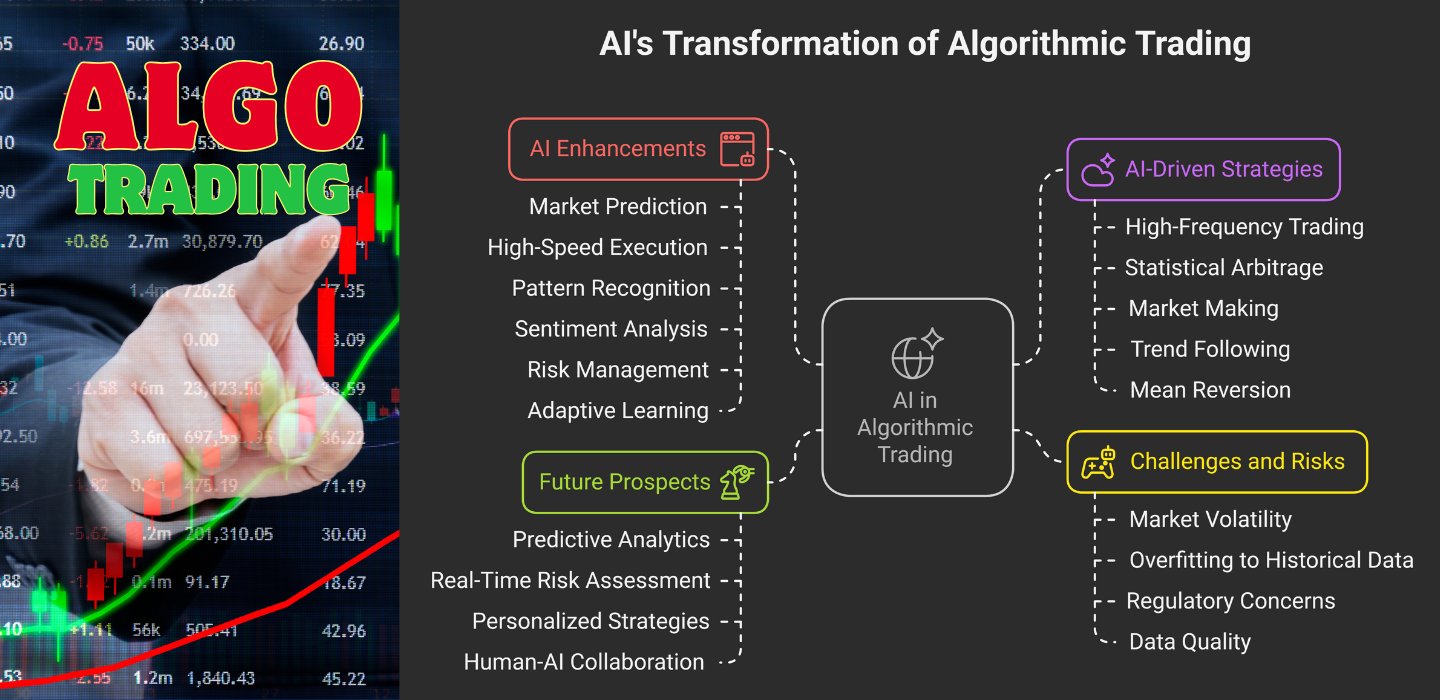Table Of Contents

How AI is Transforming Algorithmic Trading in the Stock Market
AI is changing the way financial markets operate. In traditional trading, decisions are based on human analysis, intuition, and historical data. But markets move fast, and human traders cannot process vast amounts of information in real time. This is where AI-driven algorithmic trading (algo trading) comes in. AI can analyze millions of data points in seconds, identify trading opportunities, and execute trades with precision.
What is Algorithmic Trading?
Algorithmic trading uses predefined rules, mathematical models, and automation to buy and sell stocks without human intervention. These algorithms process data, detect patterns, and make trading decisions based on market conditions. AI enhances this process by making predictions, adjusting strategies dynamically, and learning from new data.
How AI Improves Algorithmic Trading
AI does not just automate trades, it makes trading smarter. Here is how AI enhances algorithmic trading:
- Market Prediction with Machine Learning AI models analyze historical price movements, news, earnings reports, and sentiment data to predict stock trends. Unlike traditional statistical models, AI continuously improves by learning from new market conditions.
- High-Speed Execution AI-driven trading systems can execute thousands of trades in milliseconds. This speed helps traders take advantage of small price fluctuations before the market adjusts.
- Pattern Recognition AI detects trends and patterns in price movements that may not be visible to human traders. It recognizes signals for momentum trading, arbitrage opportunities, and reversal patterns.
- Sentiment Analysis AI processes news articles, social media discussions, and financial reports to gauge market sentiment. If negative sentiment spreads about a stock, AI can adjust strategies before human traders react.
- Risk Management AI monitors market conditions in real time and adjusts trading strategies to minimize losses. It can identify unusual volatility, sudden price drops, and external factors like economic reports or global events.
- Adaptive Learning and Self-Optimization AI does not rely on fixed rules. It learns from past mistakes and refines trading strategies over time. This adaptability helps hedge funds and institutions stay ahead of market changes.
Types of AI-Driven Trading Strategies
AI is used in different types of trading strategies, depending on market conditions and investment goals.
- High-Frequency Trading (HFT) AI executes large volumes of trades in fractions of a second, profiting from small price movements. This strategy is used by hedge funds and investment banks.
- Statistical Arbitrage AI identifies price inefficiencies between correlated stocks or assets and executes trades to exploit price differences.
- Market Making AI-powered trading bots provide liquidity by buying and selling securities at tight bid-ask spreads. This strategy helps stabilize the market.
- Trend Following AI analyzes technical indicators and price trends to identify when to enter and exit trades based on momentum.
- Mean Reversion AI detects when stock prices deviate too far from historical averages and makes trades expecting prices to revert to the mean.
Challenges and Risks in AI Algo Trading
While AI improves trading efficiency, it is not without challenges.
- Market Volatility AI-driven trading can amplify volatility when multiple algorithms react to the same market signals. Sudden crashes can occur if AI systems execute large trades simultaneously.
- Overfitting to Historical Data AI models trained on past data may fail when new, unpredictable market events occur. Traders need to ensure models are tested on various market conditions.
- Regulatory and Ethical Concerns Authorities monitor algorithmic trading to prevent market manipulation, unfair advantages, and system failures that could disrupt markets. Regulations require firms to maintain transparency in AI-driven strategies.
- Data Quality and Bias AI models rely on high-quality data. If data sources are inaccurate, biased, or incomplete, AI predictions can be flawed. Firms invest heavily in clean data pipelines to ensure reliability.
The Future of AI in Stock Market Trading
AI is pushing trading beyond automation, it is driving predictive analytics, real-time risk assessment, and personalized investment strategies. The rise of quantum computing, reinforcement learning, and deep learning will further improve AI’s ability to analyze markets.
Financial institutions and hedge funds that leverage AI effectively will have a competitive edge in speed, accuracy, and adaptability. However, as AI takes a larger role in trading, regulations will evolve to ensure transparency, fairness, and market stability.
AI is not replacing human traders, it is augmenting them. The best trading firms will combine AI-driven insights with human expertise to navigate financial markets with precision. The question is not whether AI will dominate trading, but how traders will evolve to work alongside AI.











